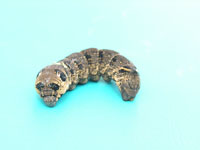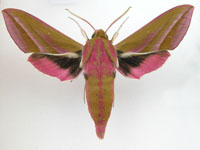The Elephant Hawk Moth (Deilephila elpenor)
The Elephant Hawk Moth (Deilephila elpenor) is a large hawk moth, with a wing span typically between 50 and 70 mm.  It is spectacularly coloured, seeming to shimmer with green and red when in motion. The larva is about 75mm long, green and brown in colour, and like most hawk moth caterpillars, having a backward curving spine or "horn" on the final segment. It has a trunk-like snout, and it is the elephant look this gives it, rather than its large size, that gives the moth its name. When startled, it draws its trunk into its foremost segment, which then looks like a large head with four large eye-like patches. The eggs are a pale glossy green, 1.2 to 1.5 mm in diameter. It is spectacularly coloured, seeming to shimmer with green and red when in motion. The larva is about 75mm long, green and brown in colour, and like most hawk moth caterpillars, having a backward curving spine or "horn" on the final segment. It has a trunk-like snout, and it is the elephant look this gives it, rather than its large size, that gives the moth its name. When startled, it draws its trunk into its foremost segment, which then looks like a large head with four large eye-like patches. The eggs are a pale glossy green, 1.2 to 1.5 mm in diameter.
The imago tends to feed in the evening, and often takes nectar from garden plants like honeysuckles and petunias, so it is quite often seen in urban settings. The preferred food plants of the caterpillar are willowherb and bedstraw, though it will also take fuchsias. The species is found throughout Britain and Ireland except for the north and east of Scotland, and its range extends across Europe, Russia, and into China, northern parts of the Indian subcontinent, Japan and Korea (though not Taiwan). Introduced specimens have been found in British Columbia. In most of their range, the adults are seen from May to July and the caterpillars from July to September, when they pupate; however in some parts of the Mediterranean and of China the adults may be seen from April on, and some will have two broods in a year.
 The adult moths are eaten by some species of bats, and the caterpillars by birds and occasionally cats. The adult moths are eaten by some species of bats, and the caterpillars by birds and occasionally cats.
The related species, the Small Elephant Hawk Moth (Deilephila porcellus) and Chitral Elephant Hawk Moth (D. rivularis) are similar but smaller and less colourful.
The images above were taken during the Earley Green Fair on Saturday 5th April. The Caterpillar was bought to the fair by a visitor who wanted it identified. The moth was part of a collection bought to the fair by Stuart Hine for display purposes.
|